The Jacques Thibaud String Trio had already impressed several CVNC reviewers when they appeared a few seasons ago on the Durham Chamber Arts Society’s series. In addition to their immaculate string playing and novel and uncommon repertory, there were the twin novelties of both playing while standing and playing without score. To this favorable impression was added, on February 12, the considerable attraction of a chance to hear them perform the greatest string trio, Mozart’s Divertimento in E-flat, K.563 (rather like calling Beethoven’s “Archduke” Piano Trio a bagatelle!). Well, “the best-laid schemes o’ mice an’ men, gang aft agley” – the trio no longer plays standing (we’re all older), and the substitution, at Elon, of a pleasant Dohnányi Serenade for Mozart’s K.563 was a blow.
The pivotal role of Viennese Royal Court Librarian Baron Gottfried van Swieten in bringing the music of J.S. Bach to a new generation of composers – Haydn, Mozart and Beethoven – has been a recurring theme in my reviews. He could be considered an early mid-wife to what would become the Bach revival. Kathryn L. Shanks Libin’s fine program notes for the Thibaud concert mention that Mozart had been aware of Bach by reputation “but did not consider (his style) to be part of his own language – until he saw Bach’s works. He was overwhelmed.” Mozart’s Six Adagios and Fugues, K.404A, represent the first stages of the composer’s reaction to Bach. The Baron had asked him to make these string trio arrangements of various pieces from The Art of Fugue and The Well-Tempered Clavier , Book I, to which Mozart added his own very un-Bach-like introductions. After the melodic preludes or introductions it was interesting to hear the fine tone and color of each instrument as each voice of the arranged fugue entered, to be followed by different pairings and contrasts. It would have been a splendid contrast to the final synthesis of the late Divertimento.
Violist Philip Douvier gave a brief history of the trio; he and violinist Burkhard Maiss had played together since high school more than a decade ago. When they decided on a life as full-time professional chamber musicians, out of some fifty cellists auditioned, only Uwe Hirth-Schmidt was willing to commit to the trio. Since they like the string trio literature and since there are hardly five full-time string trios active in the world, they choose the unusual combination as their niche and have found their career satisfactory.
Douvier’s comments about Heitor Villa-Lobos’ String Trio (1945) verged on understatement when he said it was dense! Even compared to Reger, the outer movements were too much to take in during a first hearing. He said the composer was trying to distill all he had learned in Europe with Brazilian elements. Unlike his popular Bachianas Brasileiras , there wasn’t a readily perceivable line to follow. Only the sweet and gentle slow movement was readily accessible. Douvier said that as Germans they had concentrated on musical structure but felt they might be missing something. They explored this with a number of musicians including the Brazilian Guitar Quartet, whom they struggled to understand (since neither group was fluent in the other’s language). He said the scherzo, with all three instruments playing independent lines concurrently, reminded him of their Brazilian friends, all excitedly speaking at once.
Ernst von Dohnányi’s Serenade in C, Op. 10, has had a number of Triangle performances, some under-rehearsed and all by ad hoc ensembles. The tight focus and polished ensemble playing of the Thibaud Trio made the strongest case for this work to date. It opens with a march, and the return of the trio of this march in the last movement is a salute to traditional 18th-century form. The highlight was the second movement, Romanza, with a soaring song on the violin set against slow pizzicatos from the viola and cello. The melody is explored by the others in turn, and it concludes with a surprise, in that it ends “pp” on the dominant, leaving things up in the air. Unexpected keys and nontraditional chords add to the Serenade’s unusual flavor. The finale is a rondo, somewhat reminiscent of the famous “Gypsy Rondo” of Haydn’s Piano Trio, Hob. XV.25, a popular encore piece.












